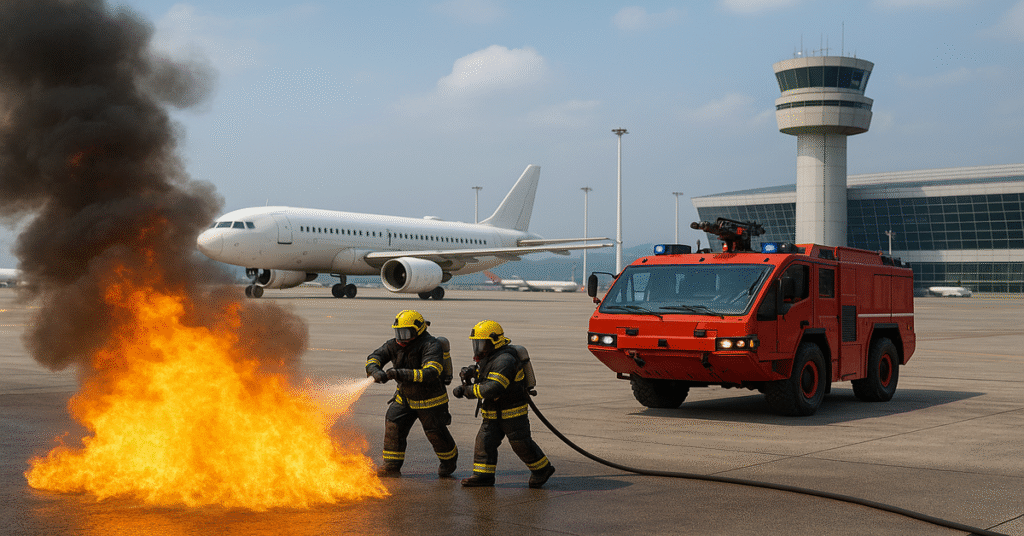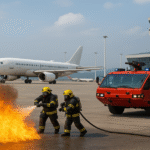Airports are complex hubs where aviation, transportation, logistics, and human activity converge. With millions of passengers, thousands of aircraft movements, and vast infrastructure, fire safety at airports is a critical concern. An airport fire, whether on the airfield, within terminal buildings, or involving aircraft, poses severe risks to human life, property, and operational continuity.
This article explores the causes of airport fires, fire prevention measures, emergency response protocols, firefighting technologies, significant case studies, and ongoing advancements in airport fire safety. Understanding how airports manage fire risks reveals the sophistication and importance of modern aviation safety systems.
The Nature of Airport Fires
Categories of Airport Fires
Airport fires typically fall into several categories:
- Aircraft Fires: Fires involving parked or in-flight aircraft.
- Fuel Fires: Resulting from spills or leaks during refueling or maintenance.
- Terminal Fires: Fires within terminals due to electrical faults, cooking equipment, or human error.
- Airside Fires: Fires on runways, taxiways, or apron areas, sometimes caused by collisions or equipment malfunctions.
- Hangar Fires: Fires in maintenance and storage areas.
Potential Consequences
- Loss of Life and Injury
- Operational Disruption
- Property Damage
- Reputational Harm
- Legal and Regulatory Penalties
Causes of Airport Fires
Mechanical Failures
Malfunctioning engines, brakes, and auxiliary power units (APUs) can ignite fires in aircraft or maintenance areas.
Electrical Faults
Old wiring, overloaded circuits, or poorly maintained equipment can lead to electrical fires, especially in terminals and hangars.
Fuel Spills
Fuel leaks or spills, particularly if ignited by heat sources or sparks, are among the most dangerous causes of airport fires.
Human Error
Improper handling of flammable materials, negligence in maintenance, or unauthorized smoking are common contributors.
Collisions and Crashes
Aircraft collisions or crashes during takeoff, landing, or taxiing can ignite fires.
Fire Prevention Measures
Strict Maintenance Protocols
Routine checks and maintenance of aircraft, fueling systems, and electrical networks reduce the risk of mechanical or electrical fires.
Advanced Fire Detection Systems
Airports deploy sophisticated fire alarm and detection systems throughout terminals, hangars, and airside operations areas.
Safe Fuel Handling Practices
Strict protocols govern fuel storage, transportation, and dispensing, including grounding procedures to prevent static electricity.
Staff Training
All personnel—from ground crews to terminal staff—receive fire safety training tailored to their roles.
Clear Zoning
Fire-resistant zones and accessible evacuation routes are integrated into airport designs.
Emergency Response and Firefighting at Airports
Airport Rescue and Firefighting (ARFF) Units
ARFF units specialize in rapid-response firefighting for aircraft and airport structures. Key responsibilities include:
- Responding to aircraft emergencies.
- Controlling fuel and structural fires.
- Assisting in passenger evacuation.
- Collaborating with municipal fire departments.
Response Time Standards
International Civil Aviation Organization (ICAO) guidelines stipulate that ARFF vehicles must reach any point within the airfield in under three minutes.
Firefighting Vehicles and Equipment
- Rapid Intervention Vehicles (RIVs): For fast response.
- Major Foam Vehicles: To smother fuel fires.
- Water Tankers: For large-scale suppression.
- High-Reach Extendable Turrets (HRETs): Allow firefighting from a safe distance.
Personal Protective Equipment (PPE)
ARFF crews use flame-resistant suits, helmets, breathing apparatus, and thermal imaging devices.
Firefighting Technology and Innovation
Fire Suppression Systems
Modern terminals and hangars use automatic sprinklers, foam suppression, and gaseous fire suppression for sensitive equipment areas.
Thermal Imaging Cameras
Allow firefighters to locate heat sources and detect hidden fires.
Drone Surveillance
Drones equipped with thermal imaging enhance situational awareness during large-scale incidents.
Simulation-Based Training
Virtual reality (VR) and advanced simulators provide realistic firefighting training scenarios without real-world risks.
Case Studies of Notable Airport Fires
1. Manchester Airport (1985)
A British Airtours Boeing 737 suffered an engine failure during takeoff, leading to a fire that killed 55 people. The tragedy prompted significant improvements in aircraft evacuation protocols and fire-resistant cabin materials.
2. Brussels Airport (2016)
A terrorist attack led to multiple explosions and fires in the departures hall, causing significant casualties and infrastructural damage. The response highlighted the importance of fire resilience in terrorism scenarios.
3. Miami International Airport (2018)
A fuel tanker fire broke out in a fueling area. Prompt ARFF response prevented injuries and major damage, showcasing effective fuel fire protocols.
Building Fire Resilience into Airport Design
Fire Zones and Compartmentalization
Airports are designed with fire compartments to prevent the spread of flames and smoke.
Fire-Resistant Materials
Construction materials are chosen for their fire-retardant properties, especially in high-traffic areas.
Ventilation and Smoke Control
Systems that direct smoke away from evacuation routes and toward vents help protect passengers.
Accessible Emergency Exits
Clear signage and accessible emergency exits are critical to ensuring efficient evacuation.
Regulatory Standards and Compliance
International Civil Aviation Organization (ICAO)
ICAO’s Annex 14 outlines standards for ARFF services, fire vehicle performance, and response protocols.
National Aviation Authorities
Each country’s civil aviation authority (e.g., FAA in the U.S., EASA in Europe) enforces specific fire safety regulations.
Fire Safety Audits
Regular audits ensure that airports comply with safety standards and identify areas for improvement.
The Role of Airport Staff and Airlines
Fire Drills and Simulations
Regular fire drills ensure staff are familiar with emergency procedures.
Collaboration with Airlines
Airlines and airport authorities collaborate to develop joint emergency response plans.
Passenger Awareness
Airports provide passengers with safety information, including fire evacuation routes and emergency contacts.
Fire Risks Unique to Airports
Fuel Farms
Large fuel storage facilities require stringent fire safety systems and continuous monitoring.
Cargo Areas
Hazardous materials and densely packed goods increase fire risk in cargo terminals.
Aircraft Hangars
The storage and maintenance of aircraft present unique fire hazards due to fuel, lubricants, and complex machinery.
Environmental Considerations
Eco-Friendly Fire Suppressants
Airports increasingly use fluorine-free foams and other environmentally safe extinguishing agents.
Water Runoff Management
Systems capture and treat water runoff from firefighting efforts to prevent contamination.
Noise and Air Pollution
Fire response activities aim to minimize environmental impact while ensuring safety.
Future of Airport Fire Safety
Artificial Intelligence and Machine Learning
AI is being used to predict fire risks based on data analysis of operations and maintenance records.
Smart Fire Detection
Sensors integrated with the Internet of Things (IoT) allow for real-time fire detection and response automation.
Renewable Energy Considerations
As airports adopt renewable energy sources (like hydrogen and electric aircraft), fire safety protocols are evolving to address new risks.
Enhanced Training Programs
Emerging technologies like augmented reality (AR) enhance firefighter training, improving readiness and efficiency.
Conclusion
An airport fire is one of the most challenging emergencies that aviation authorities must prepare for. Through a combination of prevention strategies, rapid response capabilities, advanced technology, and rigorous training, airports worldwide have developed sophisticated fire safety systems that save lives and minimize damage.
Whether dealing with an aircraft fire, a fuel spill, or a structural blaze, the coordination between airport authorities, airlines, emergency responders, and regulators is crucial. As the aviation industry continues to grow and evolve, so too will the tools and protocols designed to prevent and combat fires, ensuring that safety remains a top priority for passengers, staff, and the global community.
FAQs
1. What causes most airport fires?
Airport fires are often caused by mechanical failures, electrical faults, fuel spills, human error, and aircraft collisions or crashes.
2. What is an ARFF unit?
Airport Rescue and Firefighting (ARFF) units specialize in responding to aircraft and airport fires, using advanced vehicles and equipment.
3. How quickly must airport firefighters respond to a fire?
International standards require ARFF vehicles to reach any point within the airfield in under three minutes.
4. What fire safety systems are used in airport buildings?
Systems include fire alarms, sprinklers, foam suppression, smoke control, and emergency exit guidance.
5. How do airports train staff for fire emergencies?
Airports conduct regular fire drills, provide staff training, and use simulation-based training for ARFF personnel.
6. Are there environmental concerns with airport firefighting?
Yes, airports use eco-friendly fire suppressants and manage runoff water to reduce environmental impact during firefighting operations.







